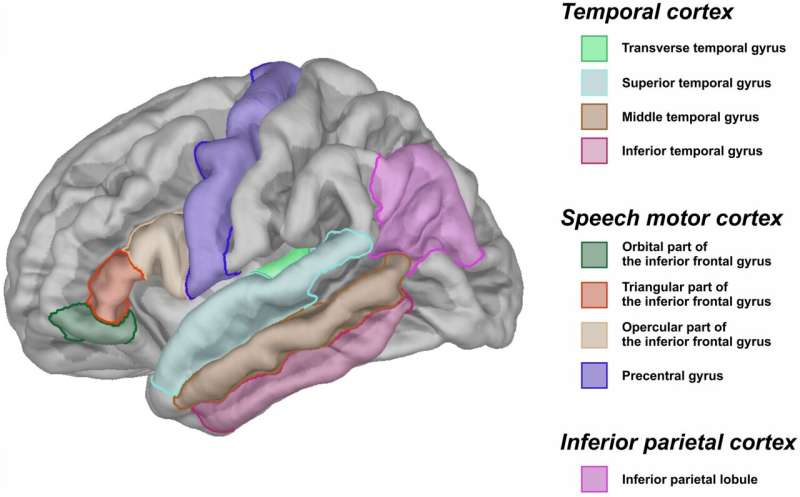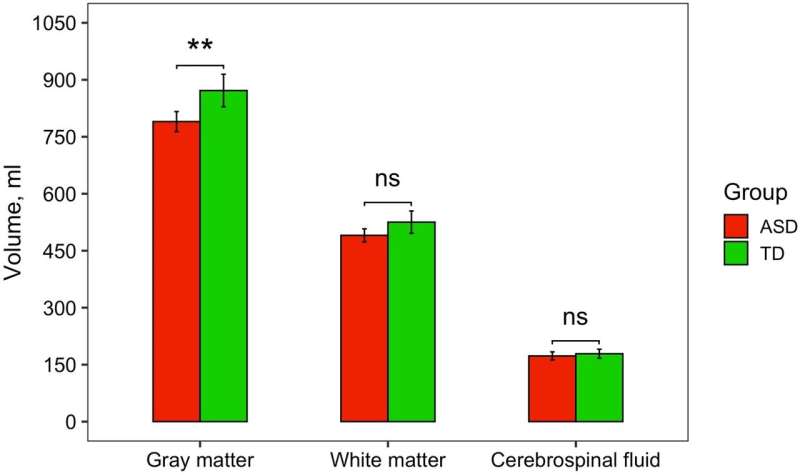This article has been reviewed according to Science X's editorial process and policies. Editors have highlighted the following attributes while ensuring the content's credibility:
fact-checked
peer-reviewed publication
proofread
Language impairment in autism associated with gray matter volume

Researchers from Russia and the U.S. have found language impairment in children with Autism Spectrum Disorder (ASD) to be associated with a lower volume of gray matter and greater gyrification in the temporal and frontal lobes of the cerebral cortex. These regions play a critical role in language functioning. Understanding the structural characteristics that underlie behavioral deficits can aid in designing special education programs for children with autism. A paper with the study's findings has been published in Scientific Reports.
Autism Spectrum Disorder is typically characterized by issues with social interaction and communication skills, and by stereotypical behaviors. These symptoms are often attributed to genetic factors that impact the development of the nervous system. Children with ASD frequently experience language difficulties, ranging from mild speech disorders to a complete inability to communicate verbally. These difficulties can become obstacles to effective communication and social interaction. But the neurobiological underpinnings of these disorders remain poorly understood, while the existing data is inconsistent.
Researchers from HSE University, the Moscow State University of Psychology and Education, and the Seattle Children's Research Institute have investigated the association between structural brain abnormalities and language impairment in children with ASD. A total of 36 school-aged children participated in the study, including 18 children with ASD and 18 age- and sex-matched typically developing controls, 13 boys in each group. Whole-brain structural MRIs were acquired for each child, and behavioral tests were utilized to measure their language abilities.
Structural MRI makes it possible to evaluate various anatomical features of the human brain, such as the volume of white and gray matter, cerebrospinal fluid, depth of the gyrus, and thickness of the gray matter in different regions of the brain. Gray matter refers to the bodies of nerve cells, whereas white matter consists of bundles of axons—connections between these cells, covered with a myelin sheath.

When comparing the results of structural MRIs for the group of children with ASD and the control group of typically developing children, the researchers did not find significant differences in the volume of white matter in any of their brain regions. In contrast, the children with ASD exhibited significantly lower gray matter thickness and greater gyrification of the cortex compared to the control group.
Further analysis revealed that the children's language abilities were significantly correlated with the thickness of the gray matter and the gyrification of the cortical regions which are critically involved in speech production, including the frontal and temporal lobes. Given that differences in gray matter were observed between children with ASD and typically developing controls, it can be inferred that the mechanism of growth of nerve cell bodies, rather than their connections, may be disrupted in children with ASD.
Children with ASD who had lower volumes of gray matter in language-related areas exhibited more pronounced language impairments. The researchers also observed another relevant pattern: the more significant the gyrification, the more severe autistic traits.
"Our findings contradict the theory that early atypical brain development in children with autism normalizes by middle school age (7-10 years old). To determine the age at which the nervous system may be restored, we need to continue studying not only toddlers and preschoolers with ASD, but also school-aged children and adults with ASD, given that the developmental characteristics of their nervous system may differ. Research on these latter two groups has been very limited thus far," says Alina Minnigulova, Junior Research Fellow at the HSE Language and Brain Centre.
According to the authors, identifying the specific structural characteristics that underlie behavioral deficits can aid in designing special education programs for children with autism.
More information: Vardan Arutiunian et al, Structural brain abnormalities and their association with language impairment in school-aged children with Autism Spectrum Disorder, Scientific Reports (2023). DOI: 10.1038/s41598-023-28463-w




















